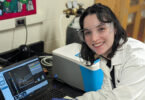As part of the UGA Signature Lecture Series, Susan Schneider, William F. Dietrich Distinguished Professor of Philosophy at Florida Atlantic University, presented a lecture entitled, “AI, Your Brain, and the Thought Data Economy.” The virtual event, held Oct. 8, examined both the pitfalls and revolutionary potential of brain microchips, artificial intelligence and neuroscience technology.
Schneider argues that humanity finds itself on the cusp of monumental technological developments, but these shouldn’t be adopted uncritically without regulations. Ongoing developments include:
- A microchip by Neuralink, a company founded by Elon Musk, that communicates data from the human brain to personal digital devices
- An artificial hippocampus currently being tested in humans
- Technology from CTRL Labs, recently acquired by Facebook, that allows people to control computers with their mind
- Wearable technology to detect one’s thoughts
- Microchips that enhance certain functions of the brain
But, as Schneider emphasized, none of these technologies are ethically and politically neutral.
While many of these technologies represent serious therapeutic breakthroughs, Schneider points out that abuses could easily follow. The artificial hippocampus can help people who have difficulty forming long-term memories. The CTRL Labs technology has the potential to help quadriplegics.
The brain enhancement microchips could potentially bring humanity to an entirely new level of intelligence. However, data communicated to a digital device could be commodified and sold to advertisers, or perhaps more shockingly, used by governments to monitor mind analytics and even thoughts.
It’s also possible that the microchip enhancements, much like higher education, would be available disproportionately to the population, exacerbating economic disparities. Conversely, people might not be able to opt out of the brain enhancements because of the economic and social pressure to keep up with and compete against others
Schneider shared serious concerns over thought privacy, and the possibility for rampant abuse of these technologies. Even so, she didn’t argue against neuroscience technology, but rather in favor of carefully monitoring its progression and for the creation of legal frameworks that can benevolently shape the technology and protect the consumer.
In forecasting what some of this technology could develop toward in the future, Schneider imagines a world in which you buy different brain enhancements in a store just like any other shopping experience. Questions this would raise about identity, beyond even consumerist concerns, extend to the possibility that people could upgrade themselves to the point of becoming posthuman.
One of the concerns with a posthuman stage is that people would no longer be who they were before the upgrades. While it’s not known whether microchips and artificial intelligence technology have the ability to support consciousness, other imaginative forecasts include upgrades beyond consciousness and enhancements in mental functioning that would move human consciousness to the cloud.
In the event of moving consciousness to the cloud en masse, humanity could reach the singularity anticipated famously by Ray Kurzweil in “The Singularity is Near.” The science fiction future that seemed to only exist in the distant future is upon us, and its technology confronts humanity with ethical and political dilemmas.







